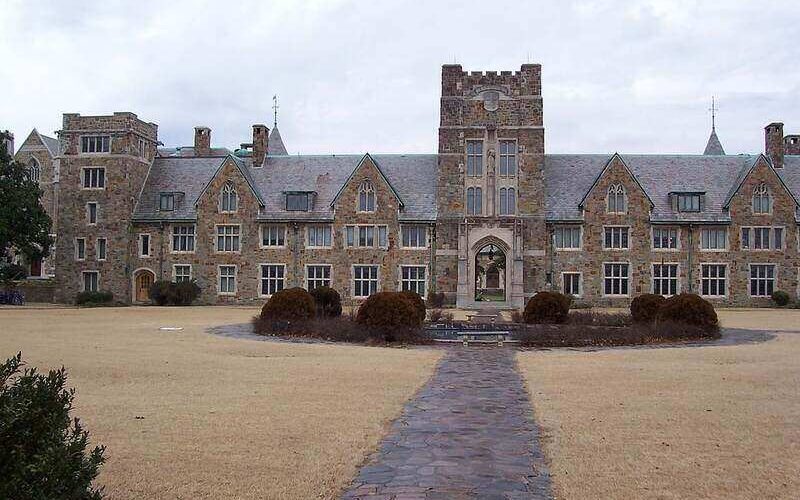Ever feel like your college campus is a bit too crowded? Maybe you dream of wide open spaces, leafy walking paths, and room to spread out. Well, get this – some universities are practically HUGE! We’re talking campuses that are thousands of acres big, that’s like tons of football fields!
In this post, we will compile the 10 largest university campuses by acres. Our compilation offers valuable information and highlights the awe-inspiring spaces that these universities provide.
Maybe you’re looking for a college with a nature vibe, or perhaps you just want some peace to study. Whatever the reason, this list is for all you lovers of wide-open spaces! Let’s see which schools have the largest university campus by acres in 2024!
Table of contents
- What is the Largest University Campus by Acres Known For?
- Benefits of Large University Campus
- Which is the Largest University Campus?
- Largest University by Size?
- Best Larget University Campus By Acres
- #1. Texas A&M University (5,200 acres)
- #2. University of Alaska Fairbanks (2.2 million acres)
- #3. Michigan State University (5,192 acres)
- #4. The Ohio State University (4,466 acres)
- #5. Pennsylvania State University (8,556 acres)
- #6. University of Florida (2,000 acres)
- #7. University of California, Davis (5,300 acres)
- #8. Purdue University (2,468 acres)
- #9. University of Montana (2,200 acres)
- #10. The University of California, Santa Cruz (2,000 acres)
- FAQs
- Conclusion
- References
- Recommendations
What is the Largest University Campus by Acres Known For?
The largest university campus by acres is known for its remarkable features and notable accomplishments. With its vast expanse, this campus offers a multitude of opportunities and amenities to its students and faculty.
Renowned for its sprawling green spaces, it provides a serene and picturesque environment that promotes a sense of tranquillity and harmony. The campus is often recognized for its impressive architectural structures that blend tradition with modernity, creating an inspiring atmosphere for learning and growth.
Moreover, this esteemed institution is known for its cutting-edge research facilities, state-of-the-art libraries, and diverse range of academic programs. It prides itself on fostering a vibrant and inclusive community where students can engage in a wide array of extracurricular activities and pursue their passions alongside their studies.
This exceptional university campus sets the stage for an enriching educational experience like no other.
Read: 15 Best Colleges with Physical Education Majors in 2024
Benefits of Large University Campus
Here are the benefits of large university campuses:
- Diverse Academic Programs: A large university campus often offers a wide range of academic programs and disciplines. This diversity allows students to explore different academic interests, pursue interdisciplinary studies, and tailor their education to align with their career goals.
- Extensive Resources: Large campuses typically provide abundant resources to support students’ academic endeavours. These resources include well-equipped libraries, research facilities, laboratories, computer centres, and specialized centres for various fields of study. Students have access to comprehensive collections of resources, facilitating in-depth research and learning.
- State-of-the-Art Facilities: These state-of-the-art facilities include advanced laboratories, cutting-edge technology, specialized classrooms, multimedia centres, and performance spaces. Such facilities enhance the learning experience and provide students with opportunities to engage in hands-on learning, practical training, and innovative research.
- Research Opportunities: With a diverse faculty body and extensive resources, students can engage in research projects, collaborate with renowned professors, and contribute to groundbreaking discoveries.
- Vibrant Student Life: Larger campuses often have a vibrant and diverse student community. Students can participate in a wide range of clubs, organizations, and extracurricular activities that cater to various interests. This fosters a sense of community, encourages social interaction, and promotes personal growth.
- Cultural and Artistic Opportunities: A larger campus typically offers a rich array of cultural and artistic opportunities. This can mean students can attend concerts, exhibitions, theatre productions, and other cultural events right on campus.
- Athletic Programs and Facilities: Larger campuses often have extensive sports facilities and a wide range of athletic programs. Students can participate in intramural sports, join varsity teams, or engage in recreational activities.
Which is the Largest University Campus?
One of the largest university campuses in the world is Texas A&M University, located in College Station, Texas, USA. Texas A&M’s campus spans over an astounding 5,200 acres, making it one of the largest university campuses in terms of land area.
Texas A&M’s claim to being the largest university campus is primarily attributed to its vast size and extensive facilities. The campus is home to numerous academic buildings, research centres, libraries, athletic facilities, and student housing complexes.
Its expansive grounds encompass beautiful landscapes, including gardens, parks, and open spaces, providing a scenic and peaceful environment for students and faculty.
In addition to its sheer size, Texas A&M University also boasts a diverse range of programs and disciplines, offering over 150 undergraduate and 250 graduate degree programs across various fields of study. The campus houses a vibrant community of students from all around the globe, fostering a rich cultural exchange and a dynamic learning atmosphere.
Furthermore, Texas A&M’s commitment to research and innovation is evident in its well-equipped laboratories, advanced technology centres, and collaborative spaces. The university actively promotes interdisciplinary research initiatives, attracting scholars and scientists to explore cutting-edge discoveries.
Texas A&M University stands out as one of the largest university campuses due to its extensive land area, comprehensive facilities, diverse academic offerings, and thriving research environment.
Read this article: What exactly is College Readiness and how Important is it?
Largest University by Size?
The University of Alaska Fairbanks is the largest university by size. Situated in Fairbanks, Alaska, USA, this university encompasses an impressive 2.2 million acres, making it the largest land area.
The University of Alaska Fairbanks’ vast size can be attributed to its unique location in Alaska, known for its expansive wilderness. The university’s land area extends beyond the main campus, encompassing various research facilities, field stations, and remote sites across the Alaskan landscape.
This large size allows the university to offer diverse academic programs and research opportunities that leverage the region’s unique geographical and environmental characteristics. It is particularly renowned for its programs in Arctic studies, natural resources, climate research, and indigenous studies.
The university’s expansive land area also provides ample space for outdoor and field-based research activities, creating a distinct advantage for students and faculty in exploring and understanding the Alaskan environment.
Related article: Best Alternatives Of Getting Around Campus In 2024
Best Larget University Campus By Acres
See the best largest university campuses in 2024 below:
- Texas A&M University (5,200 acres):
- University of Alaska Fairbanks (2.2 million acres):
- Michigan State University (5,192 acres):
- The Ohio State University (4,466 acres):
- Pennsylvania State University (8,556 acres):
- University of Florida (2,000 acres):
- University of California, Davis (5,300 acres):
- Purdue University (2,468 acres):
- University of Montana (2,200 acres):
- The University of California, Santa Cruz (2,000 acres):
#1. Texas A&M University (5,200 acres)
Texas A&M University, located in College Station, Texas, boasts one of the largest university campuses worldwide, spanning an impressive 5,200 acres.
Its vast and diverse campus features stunning green spaces, including the 2,000-acre George Bush Presidential Library and Museum, iconic architectural structures like the Memorial Student Center, and state-of-the-art facilities like research centres, libraries, and athletic complexes.
The university offers over 150 undergraduate and 250 graduate degree programs across various fields of study. With a vibrant student community, renowned athletics programs, and a commitment to research and innovation, Texas A&M provides an enriching educational experience within its expansive campus.
See Also: University Of Texas Austin Admission Requirements: SAT, ACT Score in 2024
#2. University of Alaska Fairbanks (2.2 million acres)
The University of Alaska Fairbanks is the largest university by size, covering a staggering 2.2 million acres.
Situated in Fairbanks, Alaska, the university utilizes its vast land area to offer exceptional academic programs, particularly in Arctic studies, natural resources, climate research, and indigenous studies.
Its expansive campus extends beyond the main Fairbanks campus, incorporating numerous research facilities, field stations, and remote sites across the Alaskan wilderness.
This unique advantage allows students and faculty to engage in groundbreaking research, field-based learning, and hands-on exploration of the Alaskan environment.
#3. Michigan State University (5,192 acres)
Michigan State University, nestled in East Lansing, Michigan, spans 5,192 acres of picturesque landscapes.
The campus is characterized by beautiful gardens, recreational spaces like the scenic Red Cedar River, and world-class facilities such as the Wharton Center for Performing Arts. The university emphasizes research, innovation, and community engagement and offers a wide range of academic programs across disciplines.
The campus also features cutting-edge research facilities like the Facility for Rare Isotope Beams (FRIB) and the Molecular Plant Sciences Building. Renowned for its athletics programs, vibrant student life, and commitment to sustainability, Michigan State University provides a well-rounded and immersive educational experience.
#4. The Ohio State University (4,466 acres)
Ohio State University, located in Columbus, Ohio, encompasses a sprawling 4,466-acre campus. The university’s great campus combines modern architectural marvels like the Fisher College of Business with historical landmarks such as Orton Hall.
The extensive grounds feature lush green spaces, serene lakes, and recreational areas. Offering over 200 undergraduate majors and a vast array of graduate programs, The Ohio State University is committed to research, community outreach, and diverse student organizations.
The campus also hosts renowned research facilities, such as the Wexner Medical Center and the Byrd Polar and Climate Research Center, which foster a dynamic learning environment for students.
You should also read: When Should You Start Packing for College?
#5. Pennsylvania State University (8,556 acres)
Pennsylvania State University, commonly known as Penn State, boasts a vast campus spanning an impressive 8,556 acres across multiple locations in Pennsylvania, with the main campus situated in University Park.
The expansive grounds feature a mix of architectural styles, including the iconic Old Main building and modern research facilities like the Millennium Science Complex. With over 275 undergraduate and graduate degree programs, Penn State offers comprehensive academic opportunities.
The campus is enriched by its vibrant student community, robust athletics programs, and a strong sense of unity. Penn State emphasizes research, innovation, and community impact and provides its students with a vibrant and inclusive learning environment.
#6. University of Florida (2,000 acres)
The University of Florida, located in Gainesville, Florida, covers approximately 2,000 acres of sprawling campus grounds. The campus features a blend of architectural styles, including historic buildings like the Century Tower and modern structures like the Harn Museum of Art.
The university offers a diverse range of academic disciplines, with over 100 undergraduate majors and 200 graduate programs. The campus boasts impressive research facilities, including the McKnight Brain Institute and the Emerging Pathogens Institute.
The University of Florida is known for its commitment to innovation and entrepreneurship, highlighted by its Sid Martin Biotechnology Incubator and UF Innovate initiative. With a focus on sustainability, vibrant student life, and a strong athletic program, the University of Florida provides its students with a stimulating and supportive environment.
#7. University of California, Davis (5,300 acres)
The University of California, Davis spans an expansive 5,300 acres in Davis, California. The campus is renowned for its leading agriculture, veterinary medicine, and biological sciences programs.
The university offers various academic opportunities across disciplines, including humanities, engineering, and social sciences. The campus features impressive research facilities, including the Genome Center and the Mondavi Center for the Performing Arts. UC Davis is committed to sustainability and is recognized as a leader in environmental research and initiatives.
UC Davis offers a vibrant academic environment with a focus on interdisciplinary collaboration, community engagement, and a vibrant student community.
#8. Purdue University (2,468 acres)
Purdue University in West Lafayette, Indiana, covers 2,468 acres of campus grounds. The university is renowned for its exceptional engineering, technology, and STEM programs.
The campus features a blend of architectural styles, including iconic landmarks like the Purdue Bell Tower and the Neil Armstrong Hall of Engineering. Purdue University is home to state-of-the-art research facilities such as the Purdue Research Park and the Birck Nanotechnology Center.
With a strong emphasis on industry partnerships, Purdue fosters an environment that promotes innovation and entrepreneurship. The campus offers a vibrant student life with numerous clubs, organizations, and cultural events, creating a dynamic and engaging educational experience for its students.
#9. University of Montana (2,200 acres)
The University of Montana, located in Missoula, Montana, has a picturesque campus that spans 2,200 acres. Nestled in the heart of the Rocky Mountains, it offers a stunning natural backdrop for learning and exploration.
The campus features a blend of architectural styles, including iconic buildings like Main Hall and the Payne Family Native American Center. The University of Montana offers diverse academic programs, including notable programs in environmental studies, wildlife biology, and creative writing.
The campus is home to research centres such as the Maureen and Mike Mansfield Center and the Flathead Lake Biological Station. With its commitment to sustainability, outdoor recreational opportunities, and a vibrant arts and cultural scene, the University of Montana provides a unique and enriching educational experience.
See Also: How To Get Out Of A Foreign Language Requirement In College |2024
#10. The University of California, Santa Cruz (2,000 acres)
Situated on the scenic coastal hills of Santa Cruz, California, the University of California, Santa Cruz spans 2,000 acres of breathtaking campus landscapes. Known for its alternative approach to education and interdisciplinary programs, the university offers a distinctive learning environment.
The campus is characterized by its striking architecture, including the iconic McHenry Library and the Science Hill complex. The University of California, Santa Cruz, is renowned for its research centres and institutes, such as the Center for Agroecology & Sustainable Food Systems and the Institute of Marine Sciences.
With a focus on environmental stewardship, social justice, and experiential learning, the campus fosters a sense of community, activism, and academic excellence. The stunning natural surroundings, including redwood forests and panoramic ocean views, further enhance the unique charm of this exceptional university campus.
FAQs
Texas A&M University boasts the largest university campus by acres, covering 5,200 acres.
The size of a university campus can have both advantages and disadvantages. A large campus often provides extensive facilities, ample green spaces, and diverse resources, creating a vibrant and immersive student experience. However, navigating a large campus requires efficient transportation and time management. It is essential to consider personal preferences and goals when assessing the impact of campus size on student life.
The size of a university campus does not necessarily determine its prestige. Prestige is typically associated with academic reputation, research output, faculty qualifications, and student achievements. While larger campuses often have a broader range of programs and resources, prestige is a multifaceted aspect that encompasses various factors beyond campus size.
Conclusion
A large university campus offers numerous benefits that enhance the educational experience. From diverse academic programs and extensive resources to vibrant student life and cultural opportunities, students can thrive in an environment that fosters academic excellence, personal growth, and community.
The expansive size of the campus opens doors to endless possibilities for learning, research, and exploration.
References
- Collegeraptor.com – Colleges with the largest campuses
- USAbynumbers.com – Largest University Campuses in the US
- Berry.edu – World’s Largest Campus
- Getmyuni.com – Largest University Campuses





